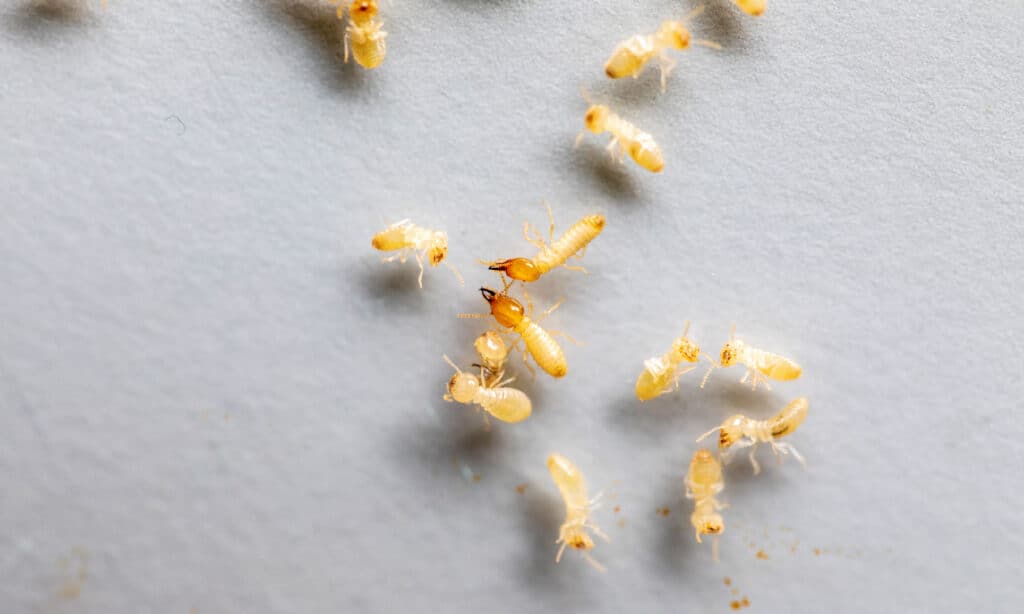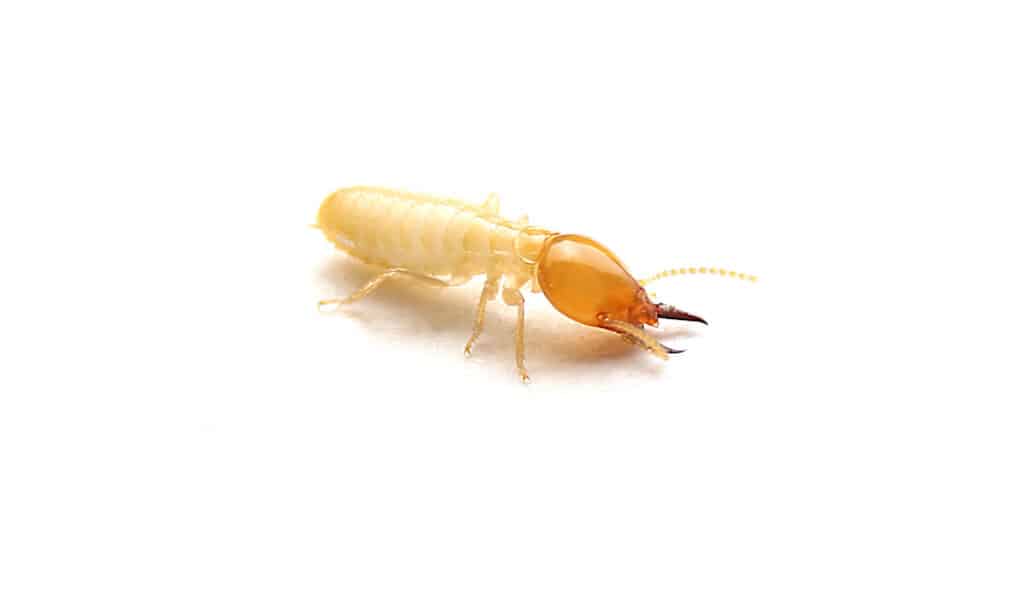Since termites frequently conceal themselves in soil, mud tubes, or food sources, it is possible to have an infestation without ever spotting a single one. But eventually, termite colonies get too crowded, and mature adults start to grow wings and come out to procreate and look for new homes, a process known as swarming.
Termite activity spikes in the springtime in Texas, and termite numbers across the Lone Star State soar when the weather heats up, and they start looking for new structures to infiltrate. In the United States, there are a few species of termite, each of which has distinguishable physical characteristics. Subterranean termites, which breed in dirt yet consume wood, are the most prevalent. But what types of termites live in Texas? And how can you get rid of them?
The prospect of termites is one of the few things that truly instills anxiety in homeowners. A single termite might not appear very damaging, but a colony of termites can quickly inflict hundreds or even thousands of dollars’ worth of damage. Below, we will explore the two main types of termites infesting Texan homes, the places they thrive, and how to get rid of them.
Termites that Live in Texas
Formosan subterranean termites and southeastern drywood termites are the two main varieties of termites found in Texas. In the state, homes suffer significant and permanent damage from these insects. All of Texas is affected by termites, including Houston, Amarillo, Midland, the Dallas-Fort Worth metro area, San Antonio, and Corpus Christi. In fact, the majority of termite populations in the United States are found in Texas. And unfortunately, due to Texas’ high humidity and moisture levels, termites could easily infest homes.
Termites are pests that eat wood. They are skilled at residing close to or inside our homes and eating on timber constructions covertly for months or even years. These destructive pests cost the US economy billions of dollars in property damage yearly.
1. Formosan Subterranean Termites

The Formosan subterranean termite is the most prevalent type of termite in Northern Texas.
©iStock.com/Sinhyu
The most prevalent type of termite in Northern Texas is the Formosan subterranean. Their subterranean colonies, which number up to two million, are all underground. Subterranean termites cause most termite damage in the United States. These termites construct huge nests surrounding your home and connect them to cellulose food supplies like trees, wooden fences, and homes timbers.
Appearance
The three forms of Formosan termites are the wingless or winged alates, the protecting soldiers, and the workers. The soldiers and winged alates are the ranks that are essential to provide an accurate identification because Formosan termite workers resemble workers of other termite families very significantly.
While native subterranean termites have rectangular heads, Formosan termite soldiers have oblong heads. A half-inch long and yellowish-brown color, alates, also known as swarmers, have transparent wings covered with a thick layer of tiny hairs. The troops defend themselves by releasing a white liquid when they are disturbed. Formosan termite soldiers are more combative when protecting the nest than native subterranean termite troops.
Habitat
Formosan Subterranean termites build their nests in the soil. They are the ones who create “mud tubes” or tunnels so they can access food sources and protect themselves from outside elements. They directly enter structures through wood-to-earth contact or mud tubes built from the ground.
Detection
Although tiny, it’s quite easy to detect subterranean termites because they work in colonies and leave visible marks: mud tubes. To access food supplies and protect themselves from the open air, subterranean termites create distinctive tunnels that resemble mud tubes. They eat wood all day long using their strong, saw-toothed jaws, which resemble scissor blades and help them bite off extremely minute pieces of wood. Like other termite species, underground termites consume cellulose-containing meals.
Threat
The most aggressive of all subterranean species, Formosan termites are known to devour wooden constructions more quickly than any other. This is because their colonies develop larger and increase more quickly than those of other termite species. Once they have infested a structure, Formosan termites are challenging to eradicate due to their aggressive behavior. A mature Formosan termite colony can consume roughly 31 grams daily. Such a colony might devour one foot of 2×4 timber in 25 days at this rate, seriously harming the structural integrity of a house in as fast as six months.
Furthermore, according to studies, numerous live plants and structural lumber are attacked by Formosan termites as they are sources of cellulose. Additionally, they are known to gnaw through the insulation on the telephone and electric line coverings, causing expensive damage and power interruptions in urban areas.
Formosan subterranean termites can enter any area of wood that comes into touch with the earth. However, they occasionally create colonies that are not attached to the ground, known as aerial colonies.
How to Get Rid of Formosan Subterranean Termites
Avoiding water ponding close to the home’s foundation is the greatest technique to control subterranean termites. You may stop these termite entrances by diverting water with properly functioning gutters. Keep mulch 15 inches away from home and store firewood at least 20 feet away from it. To prevent subterranean termite swarms from being attracted indoors, homeowners must properly ventilate their basements and attics to eliminate dampness.
2. Southeastern Drywood Termites

Southeastern drywood termites resemble other drywood termite species in appearance.
©iStock.com/witsawat sananrum
Drywood termites don’t burrow into your house from the ground like Formosan termites. Instead, they build their nests inside the dry wood pieces that make up your house’s foundation, walls, and roof. Drywood termite colonies typically have a few thousand members, and they can invade and eat healthy wood inside of your structures in addition to being drawn to the rotting wood around your home. Between early spring and late fall, these termites swarm in Texas.
Appearance
Southeastern drywood termites resemble other drywood termite species in appearance. Thus, these termites are best identified by the damage they cause to wood by chewing against its grain rather than with it. Drywood termites create oval-shaped, six-sided fecal pellets propelled via kick-out holes in the afflicted wood.
Drywood termites have wings roughly 7/16 inches in length, bright yellow to black, and clear to smoky gray. Soldier termites are similar to workers but have larger rectangular darker heads with well-developed jaws used to protect the colony. They are up to 3/8 inch long, wingless, white to grayish, and have white to yellowish-brown heads.
Habitat
Drywood termites are named after their habitat. These species consume drywood or wood that has not been weakened by water. The wood that drywood termites consume also serves as their nest. Male and female drywood termites partner up to pick the wood they want to build their colony in.
Termites can be found throughout the coastal areas of Texas, with western spot infestations occurring in Uvalde, San Antonio, and Collin County to the north. When these infestations are identified, residents become quite concerned.
Detection
Drywood termites are enigmatic creatures. As they reside deep inside the wood buildings, they are only occasionally noticed when repairs are being made to afflicted homes. They are frequently referred to as swarmers since the adults have wings for flight, and are easily identified by their feces.
Drywood non-subterranean termites can be identified by their excreta pellets or frass. Only the ends of these hard pellets are spherical; the sides have six unique concave surfaces.
Threat
These termites need whole new techniques of management because they can do just as much harm as their subterranean counterparts. They eat doorframes, cabinets, and other wooden objects. Over time, these residential constructions may become weak and unstable due to the feeding, and may even collapse.
Drywood termites could attack any wood product. Buildings’ structural timbers and carpentry, as well as furniture and other wood items, are all susceptible to damage. While these termites can cause significant harm to structures and other wood products in some parts of the United States, they are typically less dangerous than subterranean termites because they are less common. A typical drywood termite colony only has about 10,000 termites, compared to a typical subterranean termite colony’s capacity of over 500,000.
Nevertheless, termites are medically harmless to humans.
How to Get Rid of Southeastern Drywood Termites
Installing cellulose baits around your property will draw termites, who will then be given poison to bring back to the rest of the colony, where they will be eliminated one by one. Termites on your property can be tracked and treated with bait stations, preventing them from getting inside your house.
The photo featured at the top of this post is © bamgraphy/Shutterstock.com
Thank you for reading! Have some feedback for us? Contact the AZ Animals editorial team.







